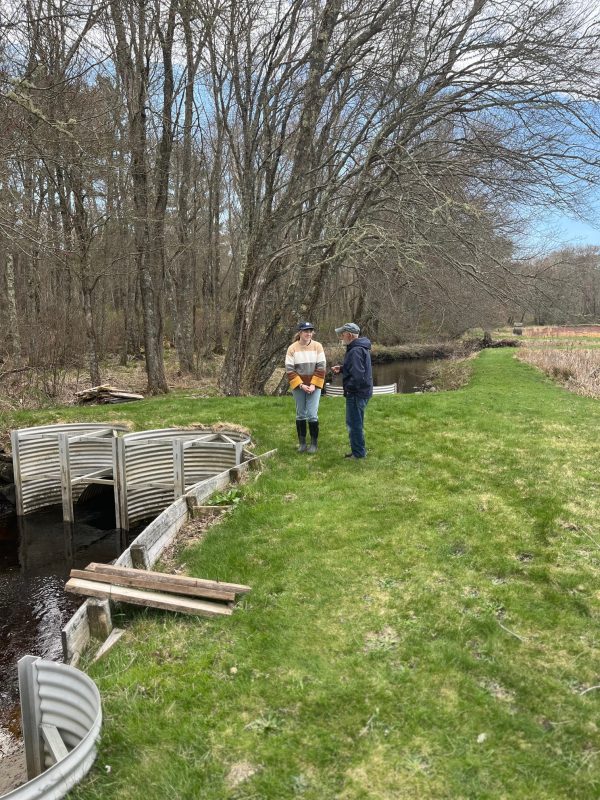Beginning the Restoration Process of Wolf Island Bogs

Evelyn Mortimer and Gerry Morris confer on the Wolf Island Bogs property by a small dam on the Mattapoisett River.
Gerry and Lucille Morris have farmed cranberries on their Wolf Island Road property in Rochester for many decades. It is a familiar spot. Not only are the bogs and their steep-roofed home visible for all to see as you head west off Mattapoisett Rd./North St., but a spot on the back berm is featured in the hallowed Rochester Memorial Day Boat Race. It’s where participants have to get out of their canoes and walk their boat around a small dam on the Mattapoisett River, which was created to make a reservoir for those bogs decades ago.
For most of Gerry’s decades as a cranberry farmer, he farmed in addition to his work as a local contractor. It was never meant to be a commercial operation, just a hobby to bring in another revenue stream. But over time, it got to be too much work for the now 80-year-old Gerry, who has come out of his house on this sunny spring day, pipe in hand, to talk to Buzzards Bay Coalition Restoration Coordinator Evelyn Mortimer. It is Mortimer’s first time visiting the property since the Rochester Conservation Commission gave permission for the Coalition to start evaluating the property for restoration.
While hobbyists would struggle to keep up with the care of a bog in their free time, Gerry was meticulous. Up until he stopped farming last year, his bogs were immaculate. As they say in the business, he “kept his ditches clean,” referring to the care he put in the irrigation waterways free of invasive vegetation. Also, he would routinely pull maple seedlings from the bog rather than apply any herbicides.
But Gerry wants to move on, and enjoy the views of the land, rather than work it. That is why research and permitting has begun to restore this area to its natural state: coastal river floodplain wetlands.
The benefits: to diversify natural habitats on the property, to minimize land stewardship so that the land can be self-sustaining, and to mitigate flooding in the area from the river. Removing the dam will restore a natural water channel for fish and other wildlife. All will lead to cleaner water.
The Coalition has proposed to install up to four temporary wells and two shallow water level monitoring wells to gauge river and groundwater levels. This will allow us to better understand the hydrology of the site so we can make deconstruction of the area as accurate and efficient as possible. Re-grading the area will allow the red maple swamp around it to creep back toward the wetland.
Engineers have been engaged to produce conceptual designs that outline potential restoration actions, including sand removal, ditch filling, grading, bog surface roughening, and seeding/selective planting to restore the bogs. As is the best practice, all sand/fill will be re-used on site.
One day, participants in the Memorial Day boat race will no longer have to walk their boat around a dam but paddle straight on through.
And Gerry is happy to watch from the comfort of his backyard.